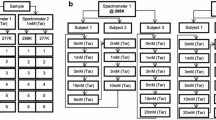Summary
Human seminal fluid, when examined by horizontal starchgel electrophoresis using 0.2 M phosphate-acetic acid buffer pH 5.0 and by specific staining of prostatic acid phosphatase (PAP) of the gel using phenolphthalein diphosphate as a substrate, has been proved to show 4 or 5 distinct zones of acid phosphatase activity, thus enabling us the classification of semen into three types, F (fast), S (slow) and 0 (zero), by their patterns of electrophoretic mobility. The frequency of PAP types of unrelated Japanese males is 71.6% S, 15.8% F and 12.6% 0. The typing by this method is independent from the erythrocyte acid phosphatase (EAP) typing. This technique has been proved to be useful in medico-legal practices (in rape cases).
Zusammenfassung
Elektrophoretische Heterogenität der sauren Phosphatase in Prostata. Elektrophoretische Untersuchung von menschlicher Samenflüssigkeit mittels Stärkegelelektro-phorese bei 0,2 M Phosphat-Essigsä ure-Pufferlösung von pH 5,0 zeigte folgende Resultate: Elektrophoretisch werden die PAP-Aktivität in 4 oder 5 deutliche Bande abgetrennt, je nach den elektrischen Mobilitäten werden F- (schnell laufend), S- (langsam laufend) und 0- (keine Bewegung) Komponente eingeteilt, damit die Identifizierungen bzw. die Einteilungen nach der Heterogenität durch die Untersuchung von Samenflüssigkeit ermöglicht werden. Beim Japaner ist 71,6% S, 15,8% F und 12,6% 0. Die Heterogenität ist unabhängig von derselben der sauren Phosphatase in Erythrocyten. Wir haben auch festgestellt, daß die Technik in der praktischen Gerichtsmedizin (bzw. bei Notzucht) als ein unentbehrlicher Test angewandt werden kann.
Similar content being viewed by others
References
Abul-Fadl, M. A. M., King, E. J.: Properties of the acid phosphatases of erythrocytes and of the human prostate gland. Biochem. J.45, 51 (1949).
Hopkinson, D. A., Spencer, N., Harris, H.: Red cell acid phosphatase variants. A new human polymorphism. Nature (Lond.)199, 969 (1963).
Lai, L., Nevo, S., Steinberg, A. G.: Acid phosphatase of human red cells predicted phenotype conforms to a genetic hypothesis. Science145, 1187 (1964).
Giblett, E. R.: Genetic markers in human blood. Oxford-Edinburgh: Blackwell Scientific Publications 1969.
Heidel, G.: Die spurenkundliche Bedeutung der Typen der sauren Erythrozytenphosphatase. Dtsch. Z. ges. gerichtl. Med.63, 37 (1968).
Smerling, M.: Bestimmung der sauren Erythrozytenphosphatase an alten Blutalkoholproben und in Blutspuren. Arch. Kriminol.144, 1611 (1969).
Nagata, T., Dotzauer, G.: Nachweis und Typenbestimmbarkeit der sauren Erythrozytenphosphatase in Blutspuren. Z. Rechtsmedizin67, 359 (1970).
Brinkmann, B., Günnemann, M., Koops, E.: Investigation on the decay of acid phosphatase types in stored blood stains and blood samples. Z. Rechtsmedizin70, 68 (1972).
Author information
Authors and Affiliations
Additional information
Auszugsweise vorgetragen anläßlich des 6. Internationalen Kongresses für forensische Wissenschaften, Edinburgh, 21.-26. September 1972.
Rights and permissions
About this article
Cite this article
Ueno, S., Yoshida, H. The electrophoretic heterogeneity of prostatic acid phosphatase. Z Rechtsmed 72, 169–173 (1973). https://doi.org/10.1007/BF02079404
Received:
Issue Date:
DOI: https://doi.org/10.1007/BF02079404




